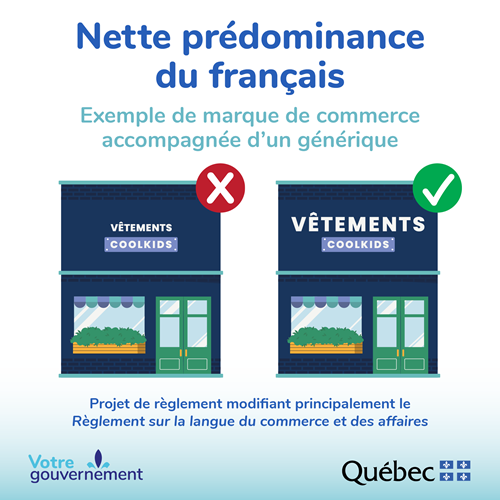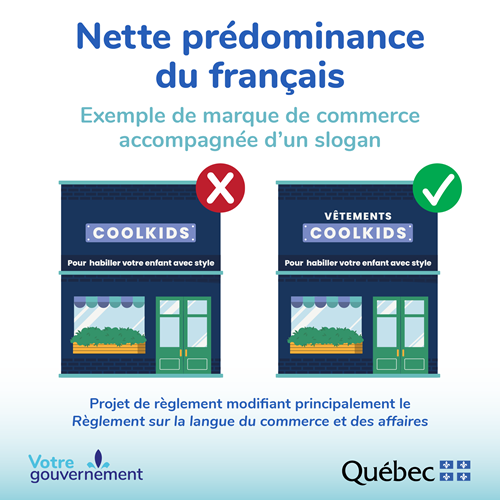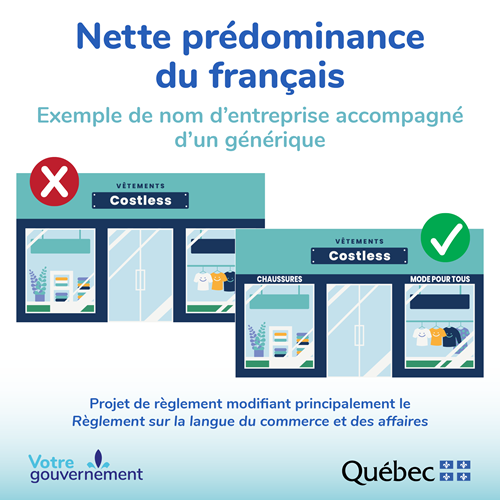On Jan. 10, 2024, the Québec government published its long-awaited draft Regulation to amend mainly the Regulation respecting the language of commerce and business (the draft Regulation).
If adopted in its current form, the draft Regulation would accompany Bill 96 (enacted on June 1, 2022), which introduced significant amendments to the Charter of the French language (the Charter). The impact of Bill 96 has already been significant for those doing business in the province of Québec. It affects, in particular, all manner of advertising, including public signage, digital advertising, and product packaging and labelling. The draft Regulation was prepared with a view to support Bill 96 and to provide clarification of specific wording it contains. It also proposes to amend the Regulation respecting the language of commerce and business and to revoke the Regulation defining the scope of the expression “markedly predominant” for the purpose of the Charter of the French language. Key proposed changes affecting public signage are discussed below. For insight on key proposed changes affecting markings on products, please see here.
Public signage
Current regime (applicable until June 1, 2025)
The general rule under the current regime is that public signs and posters as well as commercial advertising in Québec must be in French. While they may also be both in French and another language, the French version must be markedly predominant relative to that other language.
The general rule has several exceptions, including the “recognized trademark exception”. This exception allows for the display of non-French trademarks (such as English-only trademarks) – whether registered or not – on public signs and posters and in commercial advertising without the need to translate the trademark in question into French. This example applies provided that the text is being used as a recognized trademark and if there is no corresponding French version of the trademark on the Canadian Trademarks Register. However, when trademarks are displayed on storefront signage, a “sufficient presence of French” must be ensured within the same visual field.
Proposed amendments under Bill 96 (applicable as of June 1, 2025)
Bill 96 adds an important restriction in respect of the appearance of public signs and posters that are visible from outside premises (e.g., storefront signage).
While under Bill 96, the “recognized trademark exception” allows for non-French registered trademarks to appear without any translation on signs, posters and commercial advertising, the same exception is not available for public signs and posters that are visible from outside the storefront or premises or those located within a store that are also visible from outside the store. In such instances, French text will need to be given marked predominance over the non-French text. This restriction is set to come into effect on June 1, 2025.
Interestingly, the draft Regulation does not consider a “recognized trademark exception” to include pending trademark applications.
Draft Regulation (Published on Jan. 10, 2024)
The draft Regulation published by the Québec government proposes the following changes:
- Revised definition of “markedly predominant”: Under the current definition, having twice as many French signs or posters or having the space allotted to French text on a poster or sign be twice as large as the space allotted to text in another language would be compliant with the “markedly predominant” requirement.
The draft Regulation proposes to repeal the specific regulation defining “markedly predominant” and to replace it with a new definition which proposes that “marked predominance” requires the text in French to have a “much greater visual impact than the text in the other language”.
In practice, this means that, within the same visual field (i.e., visible and legible at the same time without having to move):
- the French text must be at least twice as large as the text in another language; and
- the legibility and permanent visibility of the French text must be equivalent to the legibility and permanent visibility of the text in another language.
"Permanent visibility” refers to material that cannot be easily removed or torn off.
The “twice as large” requirement will not necessarily require that all French text displayed on public signs and posters be twice as large as the text shown in another language. Rather, the determination of which French elements to display in that manner (twice as large) will depend on the number of French elements appearing on the public sign or poster. If a single French term appears on storefront signage, the French term will need to be twice as large as the English-only term (even if that term is a registered trademark). However, if several French elements appear on the storefront signage, it is the combined space allotted to the French terms that will dictate the application of the “twice as large” requirement: the combined space allotted to French text (including registered trademarks) will need to be twice as large as the combined space allotted to the English-only (or non-French only) text (including registered trademarks).
See below examples provided by the Government of Québec for what would be considered use of a trademark on storefront signage in compliance with the new proposed “markedly predominant” requirement when only a single French element is added.

Source: Gouvernement du Québec
Example 1: An English-only trademark is accompanied by a single French descriptor of the goods offered (“vêtements”). The draft Regulation requires that the French text appear in a markedly predominant manner (i.e., twice as large) as the non-French text (including the trademark). Considering that a single French element appears in the same visual field, the French element needs to be twice as large as the English-only trademark.
- Visible from outside premises: The draft Regulation clarifies the scope of the expression “visible from outside premises” contained in the Charter. What is “visible from outside premises” now includes both what appears outside the façade of a building as well as what may appear outside the façade of a storefront located within a building such as a storefront located within a shopping mall.
- Addition of French to ensure markedly predominance: When a non-French trademark appears on public signs and posters visible from outside premises, French terms must be added to ensure that French is markedly predominant. Such terms include, but are not limited to, generic terms, descriptive terms that identify the products or services offered, or slogans. While a similar requirement exists under Bill 96, the Québec government provides additional examples where French would be considered to be markedly predominant (i.e., twice as large) under the new requirements.


Source: Gouvernement du Québec
Examples 2 and 3: Signs featuring non-French trademarks and several French descriptive expressions (“Vêtements”, “Chaussures”) or slogans (“Pour habiller votre enfant avec style”, “Mode pour tous”).
A review of these examples suggests that, depending on the amount of French text shown on public signs and posters visible from outside premises, the “much greater visual impact” requirement may be achieved without the need to display each item of French text in a size that is twice as large as the non-French text. Ultimately, it is French, in its entirety, that needs to be twice as large as any non-French text, and not each French item individually.
When considering examples 1, 2 and 3 above, it seems that one way to ensure that non-French trademarks will be prominently displayed on storefront signage while remaining compliant with the new proposed definition of “markedly predominant” will be to add several generic terms, descriptive expressions or slogans.
How to prepare for the coming into force of the regulation (if adopted)
While the draft Regulation is subject to a 45-day consultation period starting on Jan. 10, 2024, and is thus not yet in its final form, those operating a brick and mortar store location in the province of Québec may wish to take certain steps in advance to ensure that signage for physical locations within the province of Québec is compliant with the requirements of Bill 96 and the draft regulation.
1. Reviewing the trademark portfolio to ensure trademarks are registered. As there is no provision allowing for pending applications to be considered as registered trademarks for public signage and commercial advertising, any non-French trademark being displayed on public signage and commercial advertising that has not been registered as of June 1, 2025 will need to be translated.
This new provision will significantly impact those doing business in the province of Québec as the current deadlines with the Canadian Intellectual Property Office are such that any application filed as of the date of this article may not be registered by June 1, 2025.
As such, trademark portfolios should be reviewed to ensure that any trademarks that appear on signage, posters and other commercial advertising to which the Regulation applies are registered and renewed. Further, we encourage business owners to inquire about the possibility of achieving accelerated examination for pending applications.
2. Reviewing the applicable signage limitations. For many, the space allocated to storefront signage is limited, whether by the size of the entire sign or based on applicable bylaws or municipal requirements.
To ensure that French is markedly predominant, French text will likely need to be added and that text will need to be legible and permanently visible in the same manner as any non-French text. Business owners will therefore need to ensure that when considered in its entirety, French has a “much greater visual impact” (i.e., is twice as large while having the same legibility and permanent visibility) than non-French text (including trademarks) prior to incurring the costs related to the modification of storefront signage.
3. Develop new generics, slogans or descriptors. Considering the upcoming June 1, 2025 deadline, business owners may wish to work closely with marketing teams to develop new generic terms, slogans or descriptive terms or expressions to add to storefront signage to render the signage compliant. In addition to the numbers of French elements added, businesses will need to review the position of those French elements to ensure the French is twice as large and as legible and permanently visible. The challenge for business owners will be to comply with these requirements without sacrificing a storefront’s “curbside appeal”.
Should you have any questions regarding the draft Regulation, the Charter of the French language or their respective application in the province of Québec, we invite you to contact one of the authors of this publication and key contacts, from our Intellectual Property and Regulatory team.
Read our related publication: Part I – Markings on products.




